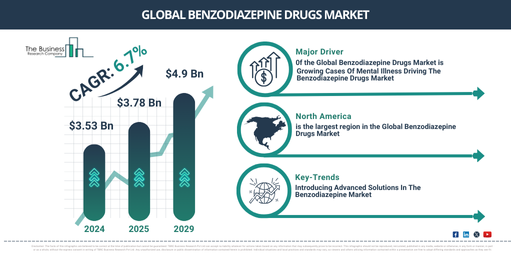Multidrug Resistant Bacteria Outlook 2034: Key Drivers, Trends, and Market Frontiers
Discover trends, market shifts, and competitive outlooks for the multidrug resistant bacteria industry through 2025-2034 with The Business Research Company’s reliable data and in-depth research
How Fast Is The Multidrug Resistant Bacteria Market Expected to Grow Between 2025 And 2029?
In recent times, the market size for multidrug resistant bacteria has markedly expanded. It’s projected to increase from $12.61 billion in 2024 to $13.4 billion in 2025, with a compound annual growth rate (CAGR) of 6.2%. Factors such as the crisis of antibiotic resistance, progress in drug discovery, regulatory incentives, and public health programs have contributed to the growth during the historic period.
Expectations are high for substantial expansion in the market size of multidrug resistant bacteria in the coming years. The market, forecasted to reach a value of $17.5 billion in 2029, is predicted to have a compound annual growth rate (CAGR) of 6.9%. Contributing to this anticipated growth during the forecast period are factors such as antibiotic stewardship programs, worldwide resistance spread, phage therapy and alternative treatments, along with both public and private investments. Key trends to watch during the forecast period would be precision medicine approaches to infectious diseases, combination therapies, ongoing surveillance and monitoring, and global cooperation.
Download a free sample to assess the report’s scope and structure:
https://www.thebusinessresearchcompany.com/sample.aspx?id=13044&type=smp
How Are Key Drivers in the Industry Acting as Catalysts for the Growth of the Multidrug Resistant Bacteria Market?
The escalation in the incidence of infectious diseases is predicted to stimulate the expansion of the multidrug-resistant bacteria market in the future. Illnesses caused by harmful microbes, such as bacteria, parasites, viruses, or fungi, are identified as infectious diseases. The connection between multidrug-resistant bacteria and these diseases is strong, owing to the bacteria’s capacity to cause infections which pose challenges in treatment with usual antibiotics. This resistance to multiple antibiotics decreases the bacteria’s susceptibility to drugs typically used in treating bacterial infections. As an example, the Centers for Disease Control and Prevention, a national public health institution based in the U.S., published an article in November 2023 stating a rise in tuberculosis cases in the USA, from 8,320 in 2022 to 9,615 in 2023, marking a growth of 1,295 cases. Thus, the mounting occurrence of infectious diseases is projected to contribute to the surge of the multidrug-resistant bacteria market.
Which Segments in the Multidrug Resistant Bacteria Offer the Most Growth?
The multidrug resistant bacteria market covered in this report is segmented –
1) By Disease: Urinary Tract Infection, Intra-Abdominal Infections, Blood Stream Infections, Clostridium Difficile Infections, Acute Bacterial Skin And Skin Structure Infections, Hospital Acquired Bacterial Pneumonia, Acquired Bacterial Pneumonia, Other Diseases
2) By Drug Class: Oxazolidinones, Lipoglycopeptides, Tetracyclines, Cephalosporins, Combination Therapies, Other Drug Classes
3) By Route Of Administration: Oral, Parenteral, Other Routes Of Administration
4) By End-User: Hospitals, Specialty Clinics, Homecare, Other End-Users
Subsegments:
1) By Urinary Tract Infection: Cystitis, Pyelonephritis
2) By Intra-Abdominal Infections: Appendicitis, Peritonitis
3) By Blood Stream Infections: Bacteremia, Sepsis
4) By Clostridium Difficile Infections: Mild CDI, Severe CDI
5) By Acute Bacterial Skin And Skin Structure Infections: Cellulitis, Abscesses
6) By Hospital Acquired Bacterial Pneumonia: Ventilator-Associated Pneumonia, Hospital-Acquired Pneumonia
7) By Acquired Bacterial Pneumonia: Community-Acquired Pneumonia, Aspiration Pneumonia
By Other Diseases: Bone and Joint Infections, Endocarditis
Request customized data on this market:
https://www.thebusinessresearchcompany.com/customise?id=13044&type=smp
What Are the Fastest-Growing Geographies in the Multidrug Resistant Bacteria Market?
North America was the largest region in the multidrug-resistant bacteria market in 2024. The regions covered in multidrug-resistant bacteria market report are Asia-Pacific, Western Europe, Eastern Europe, North America, South America, Middle East and Africa.
What Are the Current Market Growth and Trends in the Multidrug Resistant Bacteria Industry?
Key players in the multidrug-resistant bacteria market are concentrating their efforts on the creation of novel drugs and obtaining regulatory approvals, all in an attempt to cater to an emerging consumer sector. Getting the green light for drugs targeting multidrug-resistant bacteria is critical in curtailing the surge of antibiotic resistance. In a notable example, Entasis Therapeutics Inc., an American biotech firm, in May 2023 saw its new drug Xacduor, a combined antibiotic, gaining approval from the Food and Drug Administration (FDA). Xacduor is developed to combat hospital-acquired bacterial pneumonia (HABP) and ventilator-associated bacterial pneumonia (VAP) induced by acinetobacter baumannii, a notoriously stubborn pathogen. This drug combines the powers of ceftolozane, a cephalosporin antibiotic, and tedizolid phosphate from the novel oxazolidinone category. Moreover, it provides an alternative solution for patients harboring Acinetobacter baumannii infections that have proven irresponsive to other therapies. This drug can be used as an injectable dose integrating the antibiotic beta-lactam sulbactam and the beta-lactamase inhibitor wide-spectrum durlobactam, successfully diminishing acinetobacter resistance and enhancing the drug’s efficiency.
View the full report here:
https://www.thebusinessresearchcompany.com/report/multidrug-resistant-bacteria-global-market-report
What Are the Key Elements That Define the Multidrug Resistant Bacteria Market?
Multidrug-resistant bacteria refer to strains of bacteria that have developed resistance to multiple types or classes of antibiotics. These bacteria are no longer susceptible to the effects of several different antibiotics that would typically be effective in treating bacterial infections. Multidrug-resistant organisms tend to occur in hospitals and medical care facilities when antibiotics are used for longer than necessary or when they are not needed.
Purchase the full report and get a swift delivery:
https://www.thebusinessresearchcompany.com/purchaseoptions.aspx?id=13044
About The Business Research Company:
With over 15000+ reports from 27 industries covering 60+ geographies, The Business Research Company has built a reputation for offering comprehensive, data-rich research and insights. Armed with 1,500,000 datasets, the optimistic contribution of in-depth secondary research, and unique insights from industry leaders, you can get the information you need to stay ahead in the game.
Get in touch with us:
The Business Research Company: https://www.thebusinessresearchcompany.com/
Americas +1 3156230293
Asia +44 2071930708
Europe +44 2071930708
Email us at info@tbrc.info
Follow us on:
LinkedIn: https://in.linkedin.com/company/the-business-research-company
YouTube: https://www.youtube.com/channel/UC24_fI0rV8cR5DxlCpgmyFQ
Global Market Model: https://www.thebusinessresearchcompany.com/global-market-model



